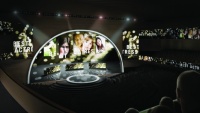
The cathode-ray tube established itself in the last century as the de-facto standard by which images were displayed and, up until the last decade, most television sets and computer monitors were built around one.
But, over the past 10 years, display technology has evolved frenetically and the limitations of the cathode-ray tube with its bulky, heavy and fragile evacuated glass tube have been overcome by a new range of liquid-crystal and plasma displays without the same disadvantages.
Nevertheless, these newer display technologies have brought with them their own set of issues – they are complex to manufacture, consume considerable power and can suffer from problems such as narrow viewing angles, poor colour rendition, burnt-out picture elements and picture burn-in.
Now there’s a new kid on the display block that promises to overcome all of these issues. Developed by a team of engineers working in ’stealth mode’ for the past five years at San Jose-based Prysm, the Laser Phosphor Display (LPD) combines old-style CRT elements with laser technology.
’We wanted to leverage existing technologies to develop a new type of display and improve on the existing technologies in terms of scalability, resolution, brightness and black levels. In the course of developing the new display technology, we were also able to demonstrate a huge improvement in terms of power consumption,’ said Dr Roger Hajjar, chief technical officer at Prysm.
Inside the company’s new LPD, an array of solid-state lasers are focused by mirrors onto a surface-emissive screen covered with phosphors. As the modulated laser beams scan across the surface of the screen, the phosphors emit red, green and blue colours, creating an image.
The approach is similar to the mechanism used in laser printers to generate images on a printing drum and paper. However, in the LPD, the image is refreshed rapidly, resulting in a high-quality video display.

In addition, the lasers are turned on and off and their intensity can be varied. By turning off the laser at points where the image is dark, the efficiency of the system is increased and the lifetime of the display is extended. This contrasts with conventional liquid-crystal displays (LCDs) or projection displays that must filter or modulate a backlight that remains on constantly.
It’s a development that Dr Hajjar claims produces a display that translates into superior image quality, a wide viewing angle, a 240Hz refresh rate and a higher contrast ratio than conventional displays.
And in terms of power consumption, the new display technology – which can be scaled up to any size, resolution and brightness, depending on the number of lasers that are used in the display – consumes the power of a single 100W light bulb per square metre of display.
In terms of the efficiency of each stage of the new design, Dr Hajjar admits that, while many power-conversion stages in the new display have been optimised to work at maximum efficiency, the company is only revealing more details with customers who have signed Non Disclosure Agreements (NDAs) with the company.
’The efficiency of the new display is something that we guard closely. But if we hook up a power meter to the display and also measure the brightness from it in lumen-per-watt numbers, we have demonstrated that, overall, the LPD is 10 times more efficient than a similarly sized plasma display,’ said Dr Hajjar.
He also divulged that the phosphor screen technology that Prysm has developed adds to the efficiency of the display. Since the phosphors on the screen are very close to the surface of the screen, the LPD is an example of a surface-emissive display technology where there is no polarisation filtering involved in generating the visible image, which is one of the reasons that the efficiency is so high.
’The process of converting the energy delivered from the lasers to excite each of the phosphors that emit the light is very efficient. That is an art that is related to the characteristics of the phosphor grain itself, how it is deposited on the screen and how it is fabricated,’ said Dr Hajjar.
Furthermore, images generated at the surface in this way are highly visible from a wide viewing angle, ensuring the advantage of LPD technology in applications such as digital signage and public-information displays – the first market that Prysm plans to address.
In addition, since the phosphor pixels are passive components, unlike those found in plasma and LCD systems, they do not experience mechanical or electrical failure. This means that the pixels remain operative for the entire life of the system and never experience frozen or burned-in images.
The LPD is also self-calibrating and adjusts the individual tile characteristics to ensure overall uniformity over the life of the display. According to Hajjar, this is one important piece of the new display technology that differentiates it from its competitors.
’An optical detector inside the display unit is used in a closed-loop feedback system to monitor and control the intensity of the laser beams to optimise the image that is created. That is especially important for very large, tiled displays because, at the present time in large displays built using light-emitting diodes, there is no such mechanism to do so,’ said Dr Hajjar.
The screen also contains additional layers that enhance the image quality. One example is an anti-glare coating that reduces glare on the screen from external light sources and reflections. This coating also enhances the visibility of the display in applications such as events, public information and digital signage.
In terms of building the new displays, Dr Hajjar believes that production costs could be significantly less than either existing LCD or plasma devices because the new LPD systems can be assembled from mass-produced components, which means that the production of the displays will not require large fabrication plants.
Following its public launch in January, the company said that it will initially target the commercial audio-visual (AV) marketplace with the technology, developing large screens for customers who might need them for sporting events, corporate environments, airports, trade shows or retail locations.
For its first foray into the market, the company will be manufacturing the displays under contract at manufacturing bases around the world. For the high-volume consumer marketplace, Dr Hajjar admits that the picture might be somewhat different.
Hajjar believes that, should the displays be mass produced on a scale comparative with existing plasma displays, there is no reason to believe that they would not be comparative in cost to existing technologies.
’We will initially be developing products for the commercial market where customers demand the higher performance our displays offer and are willing to pay a premium for the benefits. Nevertheless, LPD technology will undoubtedly be in the home over the next few years as well,’ he said.
Design essentials
The key facts to take away from this article
» The LPD contains lasers that are focused onto a surface-emissive screen
» Phosphors on the surface of the screen emit colours to create an image
» Turning off the laser at points where the image is dark increases efficiency
» The display consumes the power of a single 100W light bulb




Glasgow trial explores AR cues for autonomous road safety
They've ploughed into a few vulnerable road users in the past. Making that less likely will make it spectacularly easy to stop the traffic for...